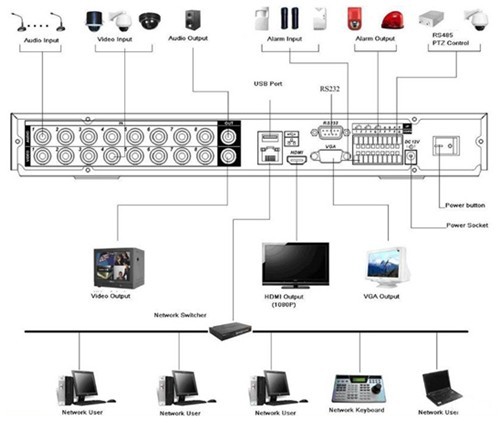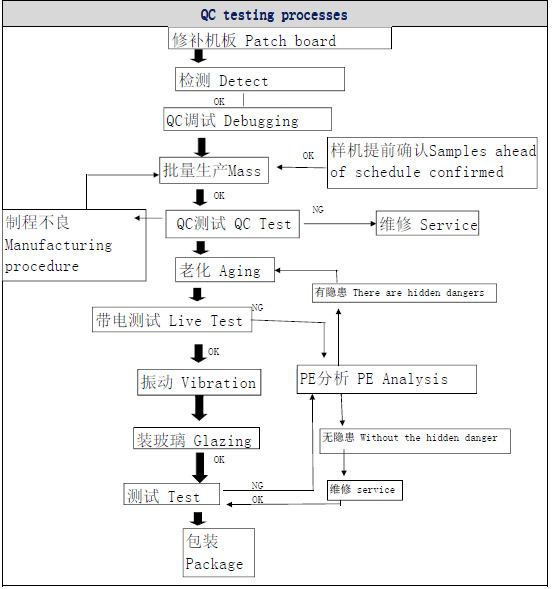What are surveillance cameras general knowledge ?
Automatic Light Compensation (ALC):
The opening in a lens that allows available light to enter the camera.
Auto White Balance (AWB):
Circuitry in a color camera that allows it to yield perfect color pictures in different types of lighting.
Automatic Gain Control (AGC):
Circuitry in a camera that allows it to improve performance in low light conditions.
Automatic Iris Lens (AI):
Type of lens where the aperture physically opens and closes to adjust the amount of light entering the camera. Available in “DC” and “Video” configurations to match your camera. Not required on cameras with electronic shutter systems.
Back Light Compensation (BLC):
Ability of a camera to balance the lighting in a scene with an extremely bright background such as sunlight.
Balun:
An impedance matching device that allows you to send video signals over UTP
BNC:
A type of video connector
C/CS Mount Lenses:
Type of lens used on a standard cctv camera
CRT:
The picture tube in a monitor
CCD:
The device in a camera that“takes” the picture and converts it to electrical signals.
Coaxial Cable:
Normally RG-59U or RG-6 in CCTV systems. This cable should have a copper center conductor and 95% copper shield for best performance.
Day/Night Camera:
A camera that displays color pictures in good lighting conditions, and automatically switches to B/W in low light conditions
Depth of Field:
The portion of a video picture that is in focus.
Digital Video Recorder (DVR):
A device that compresses and records video signals onto built in Hard Disk Drives (HDD)
Field of View- Area covered by the camera.
Focal Length:
The rated coverage of the lens in mm. Smaller numbers give a wider angle of coverage.
Format:
The size of the CCD in a camera. Common sizes are 1⁄4”, 1/3” and 1⁄2”
F-Stop:
Measurement of how much light a lens will let in. The smaller the number the more light that can enter.
Format:
The size of CCD in a camera. Common sizes are 1⁄4”, 1/3” and 1⁄2”
F-Stop:
Measurement of how much light a lens will let in. The smaller the number the more light that can enter.
Ground Loop:
When the camera and monitor are powered from sources using different grounds with different ground potentials. If a path for current flow (other than the coax) exists, ground loops are possible. Solution:Install a ground loop corrector or power all camera from the same source as the monitor.
Intensifier:
Amplifies & balances extremely low levels of visible and IR light to display usable pictures where other cameras are not able. Several technologies including WDR (Wide Dynamic Range), DNR (Dynamic Noise Reduction) and Dynamic Shutter Technology work together to display pictures in as little as .002 lux. The lack of active IR LEDs on these cameras reduces current requirements, reflectivity issues and heat build-up.
IP Address:
A string of numbers that identifies a camera or DVR on a network
Iris:
Allows you to physically change the F-stop of a lens
LCD Monitor:
Flat screen monitor used when space is at a premium. Only 2” deep.
Looping:
The ability to pass your video signal through a device and continue it on to another. Normally used in monitors.
Line Lock:
A string of numbers that identifies a camera or DVR on a network
Lux:
Measure of light equaling 1/10th of a foot-candle.
Monitor:
Displays the video signal. Does not have a tuner like a TV set.
Multiplexer:
Takes multiple cameras (up to 16) and combines them onto a single cable or screen for viewing or recording.
Observation Systems:
Complete packages that include camera, monitor, mounting bracket, cable, power supplies, etc.
Quad Splitter:
Combines four cameras onto one screen for viewing or recording.
Resolution:
Measure of a camera’s ability to reproduce details. Higher numbers are better.
Sensitivity:
Measured in Lux. Camera’s ability to operate in low light situations.Lower numbers are better.
Sequential Switcher:
Displays cameras, one at a time upon a monitor or into a VCR. The time spent on each camera before moving on to the next is adjustable.
Telephoto:
When a lens can see a long distance with great detail.
Termination:
75-ohm load placed at the end of a video line.
Time Lapse VCR:
Recorder that runs for extended periods of time (up to 40-days) on a single cassette of tape. Usually has a built-in time/date generator.
Varifocal Lens:
A lens that can be set for various focal lengths to achieve select coverage
What is DVR:
Dvr is digital video recorder,Relative to the tradition of the video camcorder, the use of video disk, we often referred to your video disk, also called dvr . it is a series of images are stored in computer system, with a long time to get a video, audio, remote monitor and control functions, dvr get the vcr and the division, head shots, the network transmission control and wait for five types of functions in one, With a device will be able to replace analog systems of the equipment function, and in the price was an advantage. dvr use of digital recording, the image processing, storage and retrieval, backup, and the remote control, etc, are far superior to impersonate the monitoring equipment, dvr of the television monitoring system development, is currently in the tv monitor system of primary products. Currently in the mainstream dvr the compression techniques have mpeg colors, mpeg -4, h. 264, m, the jpeg and mpeg -4, h. 264 is the most common form of compression; from compression card points have a soft down hard and compressed two soft down was cpu with large, not all of a real-time video displays and, gradually be eliminated from the camera a compressed ;enter into a road, number 2, 4, 6 and 9 of the road to the road, 12, 16 and 32 way, even more, Generally speaking, in the structure can be divided into two categories based on a pc :of the pc dvr and out of the pc of embedded dvr. here we speak of the pc dvr and embedded dvr.


What is an IP Camera?
IP is an abbreviation for Internet Protocol, the most common protocol for communication over computer networks and the internet. IP Camera is a camera that creates digitized video streams and transfers via a wired or wireless IP network, enabling monitoring and video recording as far away as the network reaches. In other words, using an IP camera can save a lot of money on installation since most facilities are already wired with LAN cables. Wiring coaxial cables is the major expense when implementing analog cameras. Also, it allows users to have a camera at one location while view live video at another location over the network / internet.
What is the difference between a web camera and an IP camera?
A web camera is connected to a PC, normally through USB, and uses the PC to make video available to other viewers. It will not work without a PC locally connected to the camera. An IP camera usually stands alone, and combines the functionality of a high-end web camera, the PC and network interface into one network-ready product.
How to choose a good CCTV Security Camera Surveillance System?
In the past few years the need for CCTV security surveillance systems has increased, wither its for your home or your business CCTV technologies have proven to increase security. and Just like any other technology now a days, CCTV systems are way more affordable that they used to be, but first what makes a good CCTV security camera system?
· Step 1
· Step 1
The number of Frames Per second your DVR (Digital Video Recorder) is capable of handling. First understanding what that means, A real time second of video is 30 Frames. so a recorded second or video motion that doesn’t skip is 30 Frames. So if your CCTV camera system is capable of handling 30fps that means you can record only one camera real time otherwise the 30fps will be divided into how many cameras they system might support. So when looking for a good CCTV Surveillance system make sure you get a system that does 30fps for each camera. so if you are looking for a 4 a good CCTV security camera system look for a 120fps DVR capable.
· Step 2
TV Lines supported by the CCTV cameras. A CCTV camera’s quality is measured by TV Lines, which is the number of horizontal TV lines the camera produces, and of course the higher the clearer and better picture. the average quality is 400TVL, 420TVL is good picture quality, 480TVL is higher quality and more is even Better. keep in mind that TV Lines is what mainly controls the price of the CCTV camera.
· Step 3
The Resolution of which the DVR does display and record. which is the original dimensions in pixels of the displayed or recorded video Such as 160x120, 320x240 and 640x480 and the higher is the better.
· Step 4
The HDD capacity of the CCTV DVR. which basically means the number of recorded previous days of video that the DVR will keep before recycling. most CCTV systems by default record video based on motion which means if there is no motion there is no recording because practically it will be a still image rather than video. the average for a 4 camera system is between 160GB and 250GB and the higher the more days of recorded video (motion) your DVR system keep.
· Step 5
Remote capability. Now a days a standard CCTV camera systems are remote view capable. which means you can view your cameras remotely and virtually from anywhere in the world using the internet using internet explorer or using a remote client that is installed on the PC your accessing the DVR from.
· Step 6
Back up and recovery compatibility. CCTV camera systems give you the ability to back up desired video period either on CD-R, DVD-R or USB storage including USB flash drives. Making it easy to export video to other devices for many various reasons. for example making a copy for the police or the insurance company.
QC Testing Processes... View More>>
Total: 1
Page: 1 / 1
First
←Previous
Next→
End



